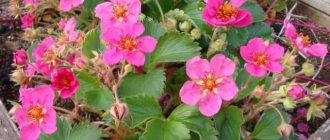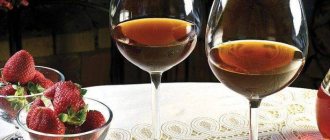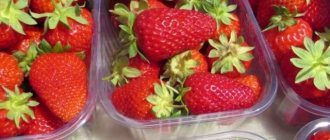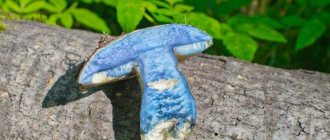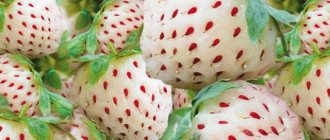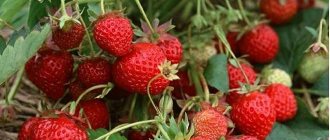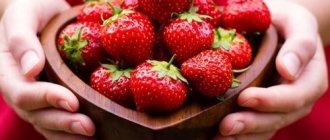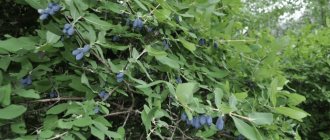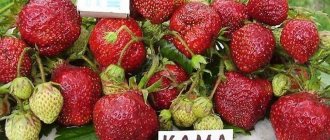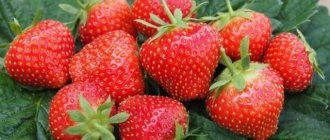Modern gardeners are great entertainers, but how could they be otherwise? After all, the main goal of gardening has long been not so much getting food, but rather the desire to experiment and surprise. But you won’t surprise anyone with black tomatoes and milky-white eggplants, but blue strawberries.
And although the Internet is already full of it, and there are plenty of offers of seeds, no one has it yet on the plots. We have to catch it before we get ahead!
Where does this color come from?
Incredible natural diversity is presented in a wide range of colors. Advances in human technology further expand natural splendor: purple roses, black tomatoes and even blue strawberries.
On the one hand, a school biology textbook says that the chlorophyll contained in their cells is responsible for the color of leaves and unripe strawberries. Chlorophyll is colored green. As strawberries ripen, chlorophyll is destroyed, making way for pigments that give the fruit a wide range of colors. Theoretically, strawberries can take on a blue tint.
On the other hand, no matter how much you search on the Internet for a real photo of a blue strawberry, you won’t find it. Either the seeds and the berries are painted the same color, or the natural redness slips through the computer processing. It seems that blue strawberries or multi-colored strawberries are a miracle of modern technology, not selection. However, there are other versions.
Let's sum it up
The grapes that come across in all the colors of the rainbow and the blue strawberries are clearly painted in Photoshop.
In this case we are talking about these grapes.
All reviews about the exotic blue berry, by and large, boil down to the fact that either nothing grew at all, or it was not a strawberry that grew, or it grew, but the usual red color. Moreover, the grown berry turned out to have a disgusting “plastic” taste.
Read also: Meteor Potatoes: variety description, reviews
On the other hand, seeds are inexpensive, and sellers sometimes send them as gifts. You can take a risk and buy not a sample. Apart from a couple of dollars for seeds and some soil for seedlings, you won’t have to lose anything. Perhaps someone, after all, will be able to boast of a photograph or video of blue exotic berries growing in the garden.
Gene modifications
There is plenty of information that the blue color of strawberries was obtained by introducing a gene from Arctic flounder. The use of genetic engineering methods in agriculture has its purpose:
- creation of new plant varieties;
- transfer of useful characteristics from species to species;
- improving the taste of the resulting crop;
- development of plant resistance to unfavorable environmental conditions.
However, it is unlikely that the Arctic flounder gene gives strawberries a shade of blue, but frost resistance is a more likely answer.
It is worth noting that there is still heated debate about the benefits and harms of genetically modified foods. In any case, you need to think carefully before eating blue or light blue strawberries.
Blue strawberry seeds
In online stores of planting material, nurseries in Russia and European countries, you cannot find seeds of either blue strawberries or blue strawberries. But on sites selling seeds from China, there will be no shortage of shades. Another question is what kind of seeds will come in the coveted bags with free delivery.
Growing strawberries from seeds is a labor-intensive process that requires adherence to basic agricultural technology. However, if you follow some recommendations, even a novice gardener can get an excellent harvest from seeds. When purchasing seeds you must:
- decide what size and flavor characteristics of berries you plan to obtain. Whether it will be a large, sweet or small berry, for consumption raw or prepared, depends only on personal preference;
- know what the expected fruiting frequency is. The market offers seeds of remontant strawberries, which bear fruit many times during the summer season. Ordinary strawberries, as a rule, bear fruit no more than once per season.
- check the integrity of the packaging and the expiration date of the seeds. You should purchase seeds in whole, undamaged packages with an unexpired expiration date. Growing strawberries from fresh seeds increases the likelihood of friendly and strong shoots.
- purchase seeds at specialized sales points. Stores that sell garden seeds usually guarantee the quality of the seeds. You can always get information from sellers in specialized stores about proper care for the selected variety.
- decide on the price. The cost of packaging seeds depends not only on the selected variety, but also on the degree of preparation of the seeds for future planting. More expensive seeds are often already treated for possible diseases and tested for germination. Advice for a novice gardener: you should pay attention to seeds in the mid-price category and avoid purchasing seeds on the street.
everything about indoor and garden flowers + floristry lessons
Despite the fact that the Park is located in the suburbs of the European capital, this does not in the least prevent Nuuksio from combining everything that is rich in the wild nature of Finland. These are 80 large lakes and swamps, picturesque meadows, valleys, ravines and rocks, clean air and silence.
The specificity of unique green air filters is such that some of them “specialize” in neutralizing harmful substances of one type, while others have a “broad spectrum of action”, and they can rightfully be considered the best.
Encyclopedia of indoor plants
Encyclopedia of indoor plants
Quotes about nature and life in general
“The jug is filled gradually, drop by drop. Just as a wise man gradually becomes filled with goodness.” - Buddha
Preparing for landing
Growing strawberry seeds, including blue ones, is done through seedlings, using any convenient container. To successfully prepare seeds for sowing, you should follow some recommendations:
- Seeds are planted for seedlings at the end of February or early March. Planting seeds early will allow young plants to become sufficiently strong before transplanting into open ground.
- In order to protect future plants from diseases, the seeds are treated with a phytosporin solution before soaking.
- To speed up germination, seeds are soaked in melt water for about two days before planting. In this case, they should be wrapped in a damp base: a cotton pad will do, and then put away in a warm, dark place.
- The recommended temperature for seed germination is 27-30 degrees.
What does color depend on?
Every schoolchild knows why grass and leaves are green. This is all due to chlorophyll, which is produced by plants in the sun. The fruits are also green at first, but this disappears as the fruits ripen, giving way to red, yellow or purple. During ripening, chlorophyll is destroyed, giving way to carotenoids (orange pigments), xanthophylls (yellow pigments) and anthocyanodes, which give a red to purple color.
It turns out that if the same pigment is responsible for red and purple colors, then strawberries may well be red and purple?
Look at the photo, here you can see blue, blue and purple strawberries. This is exotic!
Growing seedlings
Prepared seeds are sown in containers for growing seedlings, at a distance of two centimeters from each other.
The soil is moistened, and the container is covered with transparent glass or polyethylene. From the moment seedlings emerge, additional lighting should be provided for at least ten hours a day. Particular attention should be paid to maintaining optimal soil moisture. Excessive watering can provoke the appearance of mold, which is harmful to young plants. The favorable temperature regime for strawberry seedlings is 25−27 degrees. When the first true leaf appears, the glass or polyethylene must be removed from the container, and after a week the plants will be ready for picking. In May, after the soil has warmed up, the seedlings are ready to be transplanted into open ground. It is worth noting that most strawberry varieties are unpretentious to the composition of the soil, which greatly facilitates the planting process.
Plants are planted at a distance of up to thirty centimeters from each other. To prevent rotting, the green mass, as well as the future harvest, must have sufficient air access. Growing strawberries from seeds is not that difficult. Getting a good harvest from strawberry beds depends on timely feeding and proper care.
Feeding and care
To successfully grow this crop, you must follow a few simple rules. Caring for bushes of any type comes down to five main points:
- timely watering;
- weed control;
- loosening the soil;
- fertilization;
- pest control.
Watering rules
Watering strawberry bushes depends on the climatic zone of its growth, soil moisture and frequency of rain. To understand whether strawberries need watering, just dig a small hole in the garden bed and assess the soil moisture. If the soil at a depth of 5-7 centimeters is dry, then the plants should be watered. The watering schedule directly depends on the period of plant development. So, in the spring, after the snow melts and the beds dry out, it is necessary to water the bushes for the first time with warm water.
The first watering will awaken the root system, pushing the strawberries to actively grow and form green mass. Then watering is done once a week, until flowering begins. After the first flower appears, it is advisable to switch to a drip irrigation system. If drip irrigation is not possible, the soil is moistened in the usual way. It is advisable to exclude water from entering the above-ground part of the plant.
Loosening the soil
Loosening the soil around strawberry bushes improves air exchange, which has a positive effect on the development of the root system. The first loosening is carried out in the spring, immediately after the soil warms up. The soil around the bushes is loosened twice before flowering, and after flowering - as necessary.
Hilling up bushes is a unique type of loosening. Hilling is required for strawberry bushes from the second year of planting in open ground, since additional roots begin to form at the base of the plant. You should hill up the bush very carefully, trying not to cover the young leaves with soil and not damage the delicate root system.
Neighborhood with other plants
Strawberries do not tolerate close proximity to other crops, and even less so to weeds. Therefore, the key to a successful harvest is the fight against various types of weeds. Periodic weeding and mulching the strawberry beds with a layer of sawdust will help prevent the growth of weeds. A sawdust layer of 5 centimeters thick is enough to stop the development of weeds. Instead of sawdust, you can mulch the crop with a layer of loose material that allows sufficient moisture and air to pass through.
Fertilizer application
Fertilizing strawberries is aimed at forming green mass of plants, strengthening the root system and increasing yield. Feeding is done three times:
- when three sheets appear;
- before flowering;
- at the time of fruiting.
For fertilizing, it is better to choose complex, soft-acting organic fertilizers. When applying complex fertilizers, you must strictly follow the instructions. In addition to complex fertilizers, ash, manure and herbal infusions are often used to feed strawberries.
Pest Control
Warm and humid weather is an ideal breeding ground for various types of pests of garden crops, including strawberries. The process of pest control should begin in early spring with spraying the crop with specialized preparations. To control pests you can use:
- purchased chemicals. The use of chemical industry products for pest control is advisable only in the case of massive and extensive infestation. It should be understood that the unwise use of chemicals for pest control can have a detrimental effect on the quality of the harvest.
- biological drugs. Biological preparations are aimed at combating fungal and viral plant diseases.
- old folk methods. Infusions of wormwood, tobacco, and pepper are often used as folk methods.
It is worth noting that the use of biological preparations and traditional methods is the most optimal and safe for humans and the plant itself.
Gardening experience
The experience of purchasing and further growing blue strawberry seeds, described by gardeners on numerous Internet forums, indicates the frequent dishonesty of suppliers. Instead of a tasty blue berry, you can grow a big beautiful weed from the purchased seeds, or less often the familiar red berry, or even nothing will sprout at all.
The question of trust in the producer of blue strawberry seeds remains open, since the agricultural practices of Chinese farmers are strikingly different from those adopted in our homeland. The value, usefulness, and most importantly, the safety of the planned harvest primarily depend on the quality of the biomaterial used.
The embodiment of the “blue dream”
Everyone understands that a rose is not a cornflower, and blue is not its characteristic color. Nevertheless, the blue rose exists; it was bred through many years of painstaking work by geneticists. Purple carnations also did not appear naturally, but all such achievements are described in scientific journals with detailed information about the methods of production and the authors of the resulting varieties.
It’s a different matter with blue strawberries, here you shouldn’t forget about this:
- information about it can only be found from seed sellers, and not at all in reputable publications, so is it worth believing them;
- We don’t eat flowers, unlike berries, therefore, after receiving an unusual color, the flower does not need to be checked for edibility and safety of the fruit, and there is no work on the edibility of blue strawberries;
- On the Internet you can see photos of berries, but nowhere are there any pictures of the beds or videos about their cultivation.
As offensive as it may be, most likely you will have to part with your “blue dream” of blue strawberries.
DIY berries
The ripening time of strawberries depends on the selected variety, early ripening, remontancy and can range from several weeks to a month. Is it worth waiting so long when you can surprise your friends and enjoy blue strawberries right now? You will need:
- 10−12 ripe red berries;
- blue food coloring;
- packaging of powdered sugar.
Rinse the berries thoroughly under running water and let dry. Then carefully, without touching the stalk, spray a thin layer of blue food coloring onto the berry. Let the berries dry. Place on a plate and lightly sprinkle with powdered sugar. .
Whether there are blue strawberries is up to the gardeners to decide, and the desire to purchase blue strawberry seeds depends only on the degree of curiosity and adventurism.
How to get blue strawberries at home
No one had ever seen sky-colored garden strawberries in the garden. But despite this, it can be done. Without trying to outsmart genetics.
Two options:
- paint the fruits with aerosol food coloring;
- grow one of the white varieties, for example, “Paintberry” or “White Swede”. Water with water containing diluted edible dye. But such troubles are not worth it. It's easier to use food spray.
It is more rational to use such an exotic berry for decorative purposes. Do not eat this store-bought fruit. If you are not sure about the safety of the composition.
